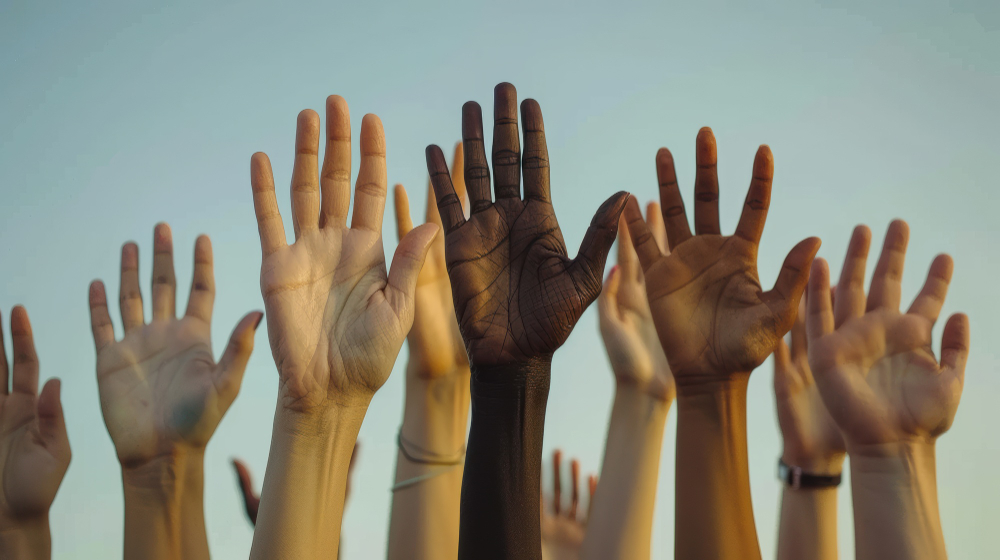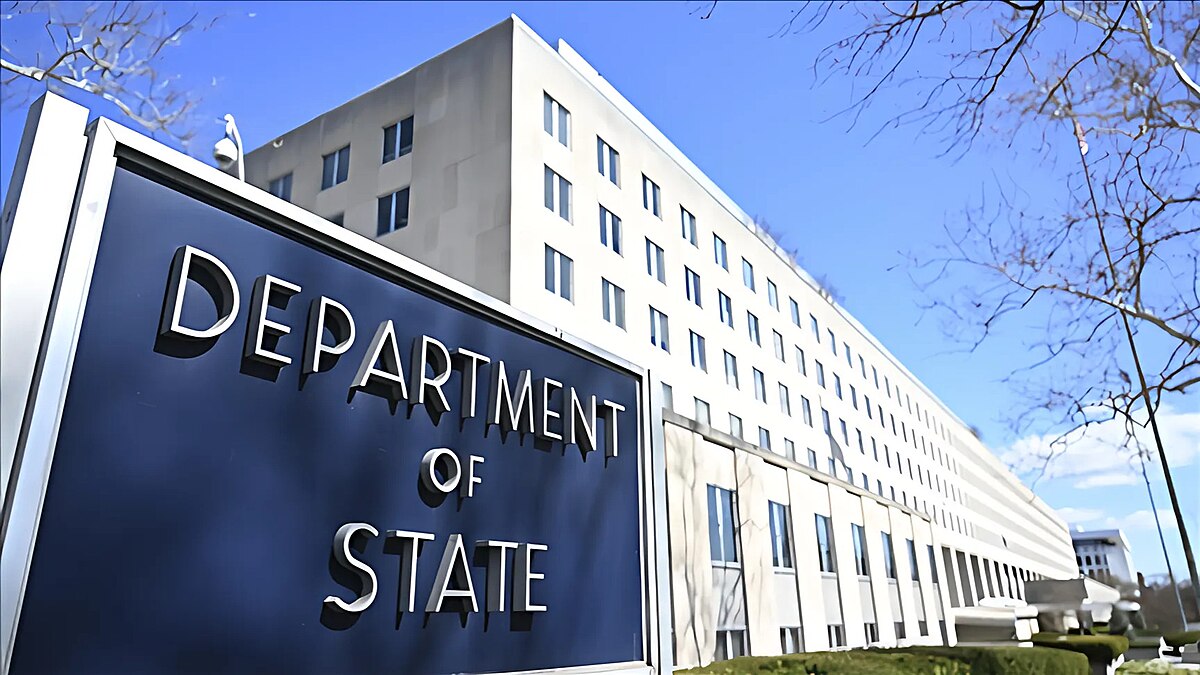- 14 3402-5578
- Rua Hygino Muzy Filho, 737, MARÍLIA - SP
- contato@latinoobservatory.org
 www.freepik.com
www.freepik.com
I. INTRODUCTION
Upon being elected president of the United States for the second time in
2024, Donald Trump returns with even harsher immigration policies compared to
his last term. The speech delivered at his inauguration, the well-known
"Liberation Day," confirmed the Republican's intention to defend
American borders as one of his top priorities, through a process of deporting
"criminal" foreigners (https://www.cnnbrasil.com.br/internacional/eleicoes-nos-eua-2024/leia-o-discurso-de-posse-de-donald-trump-na-integra/). In this sense, the
Trump administration has mobilized immigration policy as a central political
instrument, instrumentalizing repressive measures (expansion of detention and
deportations, tightening of admission rules and border control) and symbolic gestures
(security rhetoric, deployment of federal forces to cities with dissenting
local governments) to shape public perceptions of order and threat. These
practices have direct consequences on human rights: recent documentation points
to persistent harm to children separated from their families, detention
practices that violate international standards, and the risk of normalization
of punitive responses towards vulnerable populations.
Trump's new measures perpetuate state repression that uses fear and
security as a form of electoral capital, while his rhetoric, amplified by a
polarized media discourse, uses terms such as "invasion" and
"threat," transforming the immigrant, especially the Latino
immigrant, into a threat to nationals. In this way, his sensationalist speeches
about the danger of immigrants to American society serve as a basis for
justifying rigorous actions against foreigners (documented or undocumented), in
addition to increasing fear and repression against them.
The findings presented here are based on exploratory methodological
research, using the interpretation of official speeches, human rights reports,
recent news, and public opinion data as a basis. Thus, this investigation aims
to contribute to the debate on the boundaries between political power,
immigration, and human rights.
The hypothesis defended here is that contemporary migration policy
combines electoral calculation and state repression, that is, it operates
simultaneously as an instrument of coercion (administrative and police
measures) and as political capital, mobilizing fear, insecurity, and a
narrative of threat to consolidate electoral support and delegitimize political
opponents. The literature on the link between immigration, crime, and electoral
preference corroborates that security framing can alter voting intentions and
reinforce support for the conservative camp, especially when accompanied by
visible actions of the State. The proposed investigation combines (1) critical
analysis of official speeches and presidential statements to map frames and
rhetorical resources; (2) review and triangulation of reports from human rights
organizations (documenting concrete impacts on individuals and families); (3)
compilation of news and journalistic documentation to reconstruct chronologies
and executive actions; and (4) analysis of public opinion data and academic
studies that relate attitudes about immigration to electoral behavior. This
mixed approach allows for the articulation of qualitative and quantitative
evidence to evaluate both the means and ends of migration policy as a political
instrument and its effects on human rights.
In this sense, this analysis seeks to analyze the direct impact, both on
human rights and on Latino communities in the US, of the migration policies
that have been adopted in the current administration. More specifically, we
seek to understand how Trump has used migration policy and in what ways it has
manifested itself negatively. Furthermore, we will discuss the current and
potential consequences of the actions taken within the field of human rights.
2 HISTORICAL AND POLITICAL CONTEXTS OF US
IMMIGRATION POLICY
Taking a historical perspective, it is necessary to
analyze the measures taken by the American government regarding border
securitization after September 11th, a landmark event in the transformation of
immigration policy in the US. Following the attacks, there was an urgent need
to improve immigration and security controls, which were greatly strengthened
during this period of the War on Terror through increased investment in
securitization. The three main entities that received this funding were: the US
Customs and Border Protection (CBP), responsible for managing borders; the US
Immigration and Customs Enforcement (ICE), designated for enforcing immigration
laws; and the US Citizenship and Immigration Services (USCIS), which processes
immigration applications.
In terms of numbers,
these were quite significant. In the 2000s, the budget for immigration
enforcement agencies within the Department of Homeland Security (DHS) was just
under US$5 billion, while in 2020 it exceeded US$25 billion, and the number of
employees practically tripled. An important point to highlight is the number of
detentions carried out by ICE. An ever-increasing capacity was required,
reaching an estimated fifty thousand apprehensions per day in 2019.
Furthermore, when analyzing the construction of border barriers, it is possible
to note an increase in investment from US$92 million in 2005 to US$270 million
in 2006, and the Secure Fence Act was created with the objective of
increasing security measures at the borders, and the Department of Homeland
Security (DHS), which operationally controls the borders, was intended to block
terrorists (https://www.migrationpolicy.org/article/two-decades-after-sept-11-immigration-national-security).
Donald Trump's
first administration, which began in 2017, already showed signs of hostility
towards immigrants, for example, when he stated during his campaign that he
would build a wall between the US and Mexico. Furthermore, in 2018, the
"zero tolerance" policy was announced, which stipulated that migrants
who were caught attempting to cross the borders outside of an official point of
entry would be criminally charged and detained in a center until their case was
evaluated. This particularly resulted in the separation of many families, as
parents were detained at the borders in detention centers, while children were
only allowed into shelters.
The zero-tolerance policy implemented by the Trump administration
violates the international responsibilities of the United States under the
Convention Relating to the Status of Refugees and its Additional Protocol.
Article 31 of this treaty establishes that States Parties shall not penalize
refugees for their illegal entry or presence, if they come from regions where
their lives or freedoms are under threat and present themselves promptly to the
authorities, offering plausible justifications for their situation (https://www.refugeesinternational.org/reports-briefs/the-trump-zero-tolerance-policy-a-cruel-approach-with-humane-and-viable-alternatives/). The Republican also attempted to end the Deferred
Action for Childhood Arrivals (DACA) program, commonly known for preventing
the deportation of foreigners who came to the US as children but remain
undocumented. However, this was suspended by the Supreme Court. On the other
hand, the Temporary Protected Status (TPS) was also targeted by the
stricter immigration policies, as it guarantees temporary residency and work
permits to citizens of countries affected by certain types of crises, but the
government attempted to revoke the status of more than 400,000 foreigners,
arguing that conditions in those countries had improved. Several lawsuits,
however, suspended the decision, citing political motivation and a lack of
adequate technical evaluation (https://edition.cnn.com/2020/06/18/politics/daca-immigration-supreme-court).
Finally, the "Remain in Mexico" program (Migrant
Protection Protocols – MPP), created in 2019, aimed to force non-Mexican
asylum seekers to wait in Mexico while their applications were being processed
by US courts. Designated as a precautionary measure against irregular
immigration, the project resulted in the return of approximately 68,000 people
to Mexico, all under precarious conditions and without legally guaranteed
protections. Several organizations denounced systematic human rights
violations, including kidnappings, rapes, and murders in high-risk regions, as
well as family separations (https://www.americanimmigrationcouncil.org/fact-sheet/migrant-protection-protocols/).
Under the current administration, the Immigration and
Customs Enforcement (ICE) has been a central target for anti-immigration
practices, promising to operate in its campaign "the largest deportation
operation in history of the United States”. Considering this, a reshuffling of
offices was carried out several times so that the positions would be filled “by
current or retired Customs and Border Protection employees, while the other
half will be filled by ICE agents,” and according to the ambitions of the new
political agenda. This action altered the main positions “responsible for
executing the president's hardline immigration plans” and consequently
intensified enforcement and surveillance, especially in the epicenters of the
Latino community, resulting in a mass deportation of “criminal illegal
immigrants,” according to Abigail Jackson, White House spokesperson (https://apnews.com/article/immigration-border-patrol-ice-trump-deportation-69b599f8e7e7826f72b90068385a0047).
However, in the electoral sphere, the Latino community
has shown itself to be increasingly less supportive of the current
administration, while a survey conducted by the Associated Press-NORC Center
for Public Affairs Research in the second half of the year indicates that
its approval rating fell from 44% to 25% during the first six months. Thus, the
drop in popularity among the migrant community is a direct impact of its severe
anti-immigration policies, which have affected a large part of its Latino supporters
(https://www.theguardian.com/us-news/2025/oct/25/trump-hispanic-approval-rating).
Consequently, the re-election of the current president
to power represents not only the continuation, but the radicalization of an
agenda that began in 2017 and whose roots date back to post-9/11
securitization. Immigration, more than a matter of public policy, has
consolidated itself as an instrument of government and political identity, a
structuring element of the current Republican agenda.
3 THE MIGRATION AGENDA OF THE
CURRENT TRUMP ADMINISTRATION (2025)
On January 20, 2025, Donald Trump took the presidency of the United
States for the second time. As mentioned earlier, part of his inaugural address
was marked by what would become the central axis of his domestic policy in the
following months: migration issues. During his speech, the new head of state
used the term "invasion" to express his position regarding migrants,
stating that "in the last four years, the United States has suffered a
large-scale invasion, on an unprecedented level" (https://www.whitehouse.gov/presidential-actions/2025/01/securing-our-borders/). It was possible to
assess that the centrality of his speech was initially directed at subjects
considered criminals, that is, gang and faction members, traffickers, and
dangerous individuals, who would be the main targets of ICE agents. However,
over the weeks, the application of these measures has taken on different
proportions, resulting in the detention of several immigrants and, in some
cases, even American citizens. These actions have been intensified as part of
the restructuring of civilian agencies, especially ICE, which is undergoing
significant operational expansion. The institution has received investments
aimed at transforming it into the largest domestic police force in the country.
The Department of Homeland Security has allocated approximately US$170 billion
to hire 10,000 new ICE agents (bringing the total to 30,000), in addition to
8,500 additional agents for border patrol. For comparison, the FBI has
approximately 23,700 employees, 10,000 of whom are special agents (https://www.theguardian.com/commentisfree/2025/jul/09/ice-immigration-police-trump-budget-bill).
With the expansion of its structure, ICE has gained visibility due to
the change in its tactics, which have become progressively more aggressive. The
change in approach has been observed since the beginning of Trump's new term,
as one of the changes is that the agency has participated in large-scale
deportation operations in locations previously protected from immigration
enforcement, such as schools, churches, and courts. Furthermore, given the
growing belligerence of ICE, some recent records have shown federal agents
using masks during arrests and pursuits of migrants, something that,
historically, was reserved only for covert operations or the capture of highly
dangerous criminals, as experts observe.
In this scenario, the Trump administration reiterates the rhetoric of
criminalizing immigrants, legitimizing agents to adopt aggressive measures
against individuals considered resistant. However, records show that, from
October 2024 to the end of May 2025, more than 75% of those detained had no
criminal convictions, other than immigration or traffic offenses (https://www.cnnbrasil.com.br/internacional/mascaras-e-violencia-marcam-novos-metodos-de-agentes-de-imigracao-dos-eua/).
In parallel with the growing public outrage regarding ICE's actions, the
Trump administration is tightening immigration policies and altering the limits
of fundamental individual rights, including birthright citizenship, which has
been in effect for more than six decades. In practice, the government has asked
the Supreme Court to review the constitutionality of the presidential decree
that seeks to eliminate automatic citizenship granted to children of parents
without legal status. Furthermore, the same presidential order temporarily
suspends the “United States International Refugee Assistance Project,”
effective January 27, “until the additional entry of refugees is aligned with
the interests of the United States,” in addition to prohibiting the granting of
asylum to people who have recently arrived at the southern border (https://oglobo.globo.com/mundo/noticia/2025/01/21/decretos-de-trump-contra-imigracao-ocorrem-enquanto-eua-registram-menor-nivel-de-travessias-ilegais-em-4-anos-entenda.ghtml).
Still within the political rhetoric of symbolically constructing the
immigrant as a threat, the Trump administration has advanced its campaign to
mobilize the National Guard in American cities, under the argument of
protecting federal officials and buildings in the face of demonstrations
against the White House's immigration policies. Since the beginning of the
month, tensions have been intensifying in the city, where ICE agents have been
conducting operations in neighborhoods with a high concentration of immigrants,
mostly Latinos (https://www.dw.com/pt-br/trump-mobiliza-mais-tropas-da-guarda-nacional-contra-guerra-interna/a-74248712)
4
IMPLICATIONS FOR HUMAN RIGHTS
The expansion of the repressive apparatus in government actions has
provoked diverse reactions inside and outside American institutions. In this
context, on September 8, 2025, the United States Supreme Court authorized the
government to detain immigrants who speak English or Spanish with an accent, a
measure that provoked strong opposition from civil rights advocates. Justice
Sonia Sotomayor, of Puerto Rican origin, was one of the voices against the
decision. In her vote, she stated that "countless people in Los Angeles
have been detained, thrown to the ground and handcuffed simply because of their
appearance, accent or type of work," classifying the Court's position as a
"serious abuse" of the use of emergency decisions (https://exame.com/mundo/suprema-corte-autoriza-governo-trump-a-prender-imigrantes). According to reports
from the case, “individuals with brown skin are approached or removed by
unidentified federal agents, suddenly and with displays of force, being forced
to answer questions about who they are and where they come from” (https://g1.globo.com/suprema-corte-libera-governo-trump-a-deter-imigrantes-que-falem-ingles-ou-espanhol-com-sotaque). Cases like these
affect not only foreigners who cross the border illegally, but also those who
resort to the courts to remain in the country and end up facing the entire
process for months, or even years, in custody
(https://noticias.uol.com.br/suprema-corte-dos-eua-examina-detencoes-prolongadas-de-imigrantes).
The effects of this tightening are not limited to borders or detention
centers; in educational institutions, there are reports from education
professionals about school dropout among migrants since ICE operations
increased in their communities (https://www.braziliantimes.com/destaque-1/aumento-das-operacoes-do-ice-nos-eua-gera-ansiedade-e-ausencias-escolares-entre-criancas-de-familias-imigrantes/).
From this perspective, the new Trumpist policies being implemented are
causing an environment of instability and fear, and as a result, individuals
from the Latino community are being prevented from carrying out their
activities, since many fear being detained because of their physical
characteristics, even though a large part of this population is already in the
country legally. In such scenario, the questions raised about the dignity of
migrants consider a real concern for the rights of these individuals in the
United States. Therefore, to analyze the context of Latinos as a whole, one
must also look at the effects they are facing within this reality.
It is a fact that there is a scenario of worsening human rights
violations in the United States immigration system, as denounced by a coalition
of immigrant advocacy organizations before the Inter-American Commission on
Human Rights (https://www.refugeesinternational.org/statements-and-news/immigrants-rights-organizations-submit-report-to-inter-american-commission-on-human-rights-documenting-escalating-abuses-by-u-s-government/). Based on a public
hearing held this year, the groups presented a supplementary report that
describes systematic practices of repression, enforced disappearances, and
prolonged detentions, generating severe physical and psychological impacts on
asylum seekers, people with legal status in the United States, and even
American citizens of immigrant origin. The document indicates that fundamental
mechanisms of humanitarian protection, such as due process, the right to
asylum, and the guarantee of non-refoulement to places of risk, have
been interpreted restrictively, resulting in accelerated deportations, police
repression, and the separation of children from their families.
The coalition highlights that the core of the complaints lies in the
contradiction between international human rights law, to which the United
States is a signatory, and the implementation of policies that rely on
deterrence and deprivation of liberty. The groups also point out that the
conditions in the detention centers violate minimum standards of safety,
health, and personal integrity, contradicting norms established in treaties
such as the American Convention on Human Rights, the Convention relating to the
Status of Refugees, and guidelines from the United Nations High Commissioner
for Refugees. Beyond the material violations, the report (https://humanrightsfirst.org/library/report-to-inter-american-commission-on-human-rights-in-follow-up-to-july-24-2025-public-hearing-human-rights-situation-of-migrants-refugees-and-asylum-seekers/) suggests the existence
of institutional mechanisms aimed at opacity, weakening oversight, and
preventing independent monitoring, affecting social organizations, journalists,
and instances of democratic control.
5 SOCIOECONOMIC AND COMMUNITY
EFFECTS
With policies of repression against immigrants, the case in Springfield,
Ohio, (https://www.theguardian.com/us-news/2025/oct/28/springfield-ohio-economy-haitians-trump-immigration) represents the
socioeconomic impact in places where an immigrant population is concentrated.
In recent years, the city has received a significant number of immigrants,
including Latinos. This population is characterized by local workers and
entrepreneurs who have opened small businesses, generating jobs and consumers,
becoming vital to the local economy.
Based on the rhetoric used by Donald Trump during the 2024 presidential
campaign, especially the false accusation that immigrants were "eating
domestic animals", this reality changed. What might have seemed like just
aggressive rhetoric turned into fear and local threats. Families felt unsafe.
As reported by The Guardian (2025), the result was a kind of
"exodus" of workers (mainly Haitians) who fled Springfield fearing
for their safety. This exodus generated a double cost: a labor shortage,
harming local businesses, and the collapse of Latino businesses, which lost
their clientele. What was once a story of growth became unsustainable, forcing
businesses to close. This scenario demonstrates how aggressive politicization
and misinformation, used to justify repressive policies, cause immediate and tangible
economic damage to the various immigrant communities in American cities, as in
the case of Springfield, Ohio.
5.1 Family and community disruption: psychological
and social effects of migration instability.
Donald Trump's immigration policy infiltrated the daily lives of
communities, generating profound psychological and social instability. The
aggressive enforcement strategy, validated by claims of "immunity"
for ICE agents (https://time.com/7329034/stephen-miller-ice-immunity-pritzker), fostered a widespread
environment of fear.
The main documented tactic of family disruption is the
"disappearance of immigrants" under prolonged custody without
communication, a practice that reportedly affected more than 1,000 people in a
single detention center, according to the report by immigrant rights
organizations submitted to the Inter-American Commission on Human Rights,
mentioned earlier. This instability was exacerbated by what the American
Civil Liberties Union (ACLU) (https://www.aclu.org/news/immigrants-rights/trump-is-weaponizing-the-uscis-for-the-first-time-in-the-agencys-history) classifies as the
"weaponization" of the United States Citizenship and Immigration
Services (USCIS), which made immigrants afraid to seek legal avenues for
fear of deportation. Thus, this climate of insecurity, where any interaction
with the State can mean detention or family separation, weakens society and
destabilizes entire communities.
5.2 Federal tensions: conflicts between sanctuary
cities and federal deportation policies.
The intensification of Trump's deportation policies generated a strong
federal conflict, putting the federal government on a direct collision course
with hundreds of "sanctuary cities." These local jurisdictions adopt
policies that limit the cooperation of their police forces with federal
agencies, such as ICE, often refusing to honor detention requests.
The government responded to local resistance with a robust
centralization of federal authority. The first strategy was the centralization
of enforcement: the restructuring of ICE leadership (https://apnews.com/article/69b599f8e7e7826f72b90068385a0047) was a strategic
maneuver to ensure that local offices followed Washington's deportation
priorities, ignoring sanctuary policies. The second was the expansion of
federal authority: the government insisted that immigration control is
exclusively federal, institutionalizing terms like "alien" to justify
the deportation of any non-citizen, regardless of local objections.
In short, the analysis of the socioeconomic and community effects
reveals how the Trump Administration's immigration policy operated systemically
to destabilize local American life. This disruption was an essential component
of the political strategy, intended to be converted into electoral capital, the
subject of the following section.
The transition of immigration policy from the sphere of enforcement to
the electoral arena reveals the intentional instrumentalization of immigration.
The community crisis and federal conflicts served as the backdrop for the
centerpiece of Trump's electoral strategy.
The political use of immigration was based on the mobilization of fear
and the exploitation of a restrictive and exclusionary notion of national
identity, which led to irregular immigration being framed in discourses as a
"crisis" and, often, as an "invasion" that corroded the
country. This aggressive rhetoric and repressive policies had a major effect on
public opinion. The mobilized fear managed to translate into support, as
evidenced by surveys indicating that a growing share of Americans wanted the
expulsion of undocumented immigrants. (https://nypost.com/2025/10/28/us-news/even-democrats-support-one-part-of-trumps-deportation-plan-poll).
According to research compiled by the aggregator RealClear Politics (https://www.realclearpolling.com/polls/approval/donald-trump/issues/immigratio), immigration policy is
the most highly rated public issue for the current US presidential
administration, registering a net approval of 1.4 percentage points, higher
than perceptions on foreign policy, inflation, the economy, and the handling of
the war in Ukraine. Complementary data collected by the Washington-based firm JL
Partners reveals a majority trend in support of stricter measures: 69% of
respondents support the deportation of undocumented immigrants who have
committed other offenses, a position shared even by 58% of respondents
identified with the Democratic Party. The research also indicates that only 13%
reject the expulsion of individuals convicted of crimes, while half of the
participants declare support for the broad deportation of all immigrants
without legal status, in contrast to 27% who oppose this proposal. These results
suggest a sensitive political environment, in which perceptions of security and
legality shape public support for stricter immigration policies, even among
sectors traditionally aligned with pro-immigration platforms. The success of
this mobilization may be related to the government's ability to transform
border security into a symbol of national identity. Thus, immigration policy
was a primary electoral tool, used to energize the support base by reaffirming
a cultural and nationalist identity supposedly at risk.
Although anti-immigration rhetoric was intense, Trump's political
strategy exploited the complex polarization and internal divisions within the
Latino electorate, which is not a monolithic bloc. Research from the Pew
Research Center (2025) demonstrates a marked polarization: while
first-generation voters tend to reject hardline policies, second- or
third-generation Latinos show greater openness to conservative positions,
prioritizing the economy and security.
The rhetoric of "law and order" and nationalism successfully
attracted conservative sectors within the community, such as Cuban-Americans
and Venezuelan-Americans in certain regions, who see Trump's policies as a
direct contrast to the authoritarian or socialist regimes of their countries of
origin. Therefore, the strategy was not aimed at most of the Latino vote, but
rather at exploiting these fissures, converting the internal divisions and
anxieties of this electorate into electoral resources for the political project
(https://www.pewresearch.org/politics)
6.1 Media framing: the role of Fox News, social media,
and the construction of a 'migration crisis' as a political spectacle
To validate and amplify its political mobilization strategy, the Trump
Administration crucially relied on the media framing of immigration. Success in
converting fear and internal divisions into electoral support required the
construction of a spectacularized and continuous "migration crisis."
This construction was facilitated by aligned media outlets and the massive use
of social media, which amplified the narrative of collapsing borders. The peak
of this spectacularization is seen in what the ACLU (2025) classified as the
"weaponization" of USCIS, an extreme action that guaranteed headlines
and validated the perception of an existential threat.
The media framing served two crucial purposes: the justification of
policies, providing a basis for harsh enforcement measures, and the maintenance
of polarization, ensuring that immigration remained the central theme of the
agenda. By transforming immigration into a political spectacle, the government
ensured that fear and national identity were the main electoral resources.
Thus, the Trump administration used immigration as a tool of political
engineering, and not merely as a matter of government policy. The strategy was
diverse: it mobilized fear of national identity, capitalized on fissures within
the Latino vote, and secured its narrative through aggressive media framing.
This coordination demonstrates the use of the immigration issue to ensure the
mobilization of the electoral base and reshape the political landscape (https://www.aclu.org/news/immigrants-rights/trump-is-weaponizing-the-uscis-for-the-first-time-in-the-agencys-history).
The United
States' foreign policy toward Latin America, particularly in the
Mexico–Guatemala–Haiti axis, has been marked by the prioritization of migration
control as a diplomatic instrument. Since 2019, Washington has intensified
"shared accountability" agreements, in which transit countries assume
migration containment functions in exchange for economic cooperation
and diplomatic benefits. The pact signed with Mexico under the Trump
administration, partially maintained in the early years of the Biden administration,
exemplifies this approach: through the "Migrant Protection Protocols"
(MPP) program and operations by the Mexican National Guard in the south of the
country, the Mexican government acted to reduce the entry of migrants at the
northern border (https://www.cbp.gov/document/guidance/migrant-protection-protocols).
Guatemala became a key player by accepting, in 2019, the “Safe Third
Country Agreement,” which allowed the United States to deport asylum seekers
passing through its territory, even in the face of criticism from international
organizations regarding human rights violations and Guatemala's lack of
institutional capacity. Furthermore, economic pressures and the threat of
sanctions reinforced the diplomatic dependence between Guatemala and
Washington, demonstrating the strategic use of financial incentives in containing
cross-border displacement (https://www.hrw.org/report/2020/05/19/deportation-layover/failure-protection-under-us-guatemala-asylum-cooperative?).
Haiti represents another dimension of the problem: the profound
political and humanitarian crisis has intensified migratory flows, leading the
US to adopt policies of accelerated deportation and increased repatriation
flights, a measure criticized by UN agencies for violating humanitarian
protection principles (https://help.unhcr.org/usa/country-resources/unhcr-resources-on-the-conditions-in-haiti/). Although the US has
announced limited humanitarian entry programs, the number of people benefiting
is significantly lower than the number of deportees, demonstrating a logic of
deterrence.
These policies reinforce regional diplomatic tensions, as transit
countries, especially Mexico and Guatemala, begin to incorporate migration
control as a bargaining chip in trade and security negotiations. The result is
a growing externalization of US borders, shifting containment to the interior
of Latin America and producing broad social effects, such as prolonged migrant
detention and systematic human rights violations on routes through the
Caribbean and Central America.
7.1 International human rights frameworks:
conflicts with UN treaties and criticisms
from the ACLU, Human Rights Watch, and Amnesty International
International human rights frameworks, consolidated especially after
1948 with the Universal Declaration of Human Rights and subsequently with the
International Covenants of 1966 (International Covenant on Civil and
Political Rights – ICCPR, and International Covenant on Economic, Social
and Cultural Rights – ICESCR), established legal obligations for States in
the protection of human dignity. These instruments, accompanied by thematic
conventions such as the Convention against Torture (1984) and the Convention
relating to the Status of Refugees (1951), form the hard core of the
international regime of fundamental guarantees, overseen by bodies such as the Office
of the United Nations High Commissioner for Human Rights (OHCHR). However,
monitoring organizations—including the ACLU, Human Rights Watch (HRW),
and Amnesty International—argue that several States violate these
frameworks or reinterpret their provisions to circumvent international
responsibilities. The ACLU (https://www.aclu.org/news/immigrants-rights/family-separation-by-the-numbers), for example,
denounces that security and immigration measures adopted by governments such as
that of the United States generate arbitrary detentions, family separations,
and summary deportations, in violation of the principles of non-refoulement
foreseen in the 1951 Convention and reaffirmed by UNHCR (ACLU, 2021; UNHCR,
2017). Human Rights Watch also highlights conflicts between domestic
laws and UN treaty obligations, especially regarding the excessive use of
force, state surveillance, and the criminalization of migrants and human rights
defenders. Recent reports document that border policies and mass incarceration
violate the ICCPR and the United Nations Standard Minimum Rules for the
Treatment of Prisoners, the “Mandela Rules” (https://www.hrw.org/united-states/immigration?utm_source=chatgpt.com).
Amnesty International, on the other hand, emphasizes that several countries
ratify universal treaties but apply national legislation that denies basic
guarantees such as access to asylum, freedom of expression, and the right to a
fair trial. For the organization, this is a phenomenon of "symbolic
ratification", in which states participate in the international system but
ignore the practical implementation of the norms (https://www.amnesty.org/en/latest/research/).
Thus, although international human rights frameworks have high
legitimacy and broad formal adherence, independent organizations demonstrate
that conflicts between UN treaties and domestic policies reveal the system's
limitations: absence of coercive mechanisms, political selectivity, and state
resistance to international oversight. The result is a scenario in which robust
normative achievements coexist with recurring violations, pointing to the
tension between national sovereignty and the universality of human rights.
Several human rights organizations have pointed out that Donald Trump's
second term as President of the United States has produced significant negative
impacts both domestically and internationally. As mentioned, reports from
entities such as Human Rights Watch, ACLU, and Amnesty International
indicate normative and institutional setbacks in sensitive areas, including
women's rights and reproductive health, protection for migrants and asylum
seekers, LGBTQIA+ rights, and environmental safeguards (https://www.hrw.org/tag/the-trump-administration-and-human-rights).
According to these surveys, the current administration has deepened
trends already observed in its first term, such as the adoption of measures
considered incompatible with constitutional guarantees and international human
rights commitments. Among the points most frequently highlighted are the
hardening of immigration policies, marked by mass detentions, accelerated
deportations, and allegations of due process violations, as well as increased
state intervention in protests and large-scale police actions. In the
international arena, analyses suggest that substantial cuts in foreign
assistance, especially in programs focused on human rights, are combined with a
political and diplomatic rapprochement with governments accused of
authoritarian practices. For several analysts and international observers, this
stance contributes to weakening multilateral protection mechanisms and
promoting a more permissive environment for violations. Although
interpretations vary according to the orientation of the sources consulted,
there is consensus in some of the specialized literature that current policies
have significant repercussions on individual guarantees, democratic
functioning, and the international credibility of the United States in the
field of human rights.
In the institutional field, we can highlight the existence of tensions
between the Executive branch and state and federal authorities, as well as
judicial challenges to the constitutionality of warrantless immigration
operations, and the cooperation between police agencies and ICE for mass
arrests. Organizations such as Amnesty International observe that
official discourse has contributed to reinforcing stigmas against migrants, a
phenomenon associated with the growth of acts of violence and hostility recorded
by centers monitoring crimes motivated by xenophobia.
On the social and political level, research from the Pew Research
Center (https://www.pewresearch.org/short-reads/2025/04/30/latinos-worry-more-than-other-us-adults-about-deportations/) reveals that
anti-immigration rhetoric intensifies polarization and produces dehumanizing
perceptions of immigrants, often portrayed as a criminal or economic threat.
However, the same institute shows that sectors of organized civil society,
including networks of lawyers, universities, and religious organizations, have
expanded litigation and humanitarian assistance efforts, seeking to curb
violations and pressuring the judiciary to halt policies considered
unconstitutional.
Among Latino communities, research has demonstrated the ambivalent
electoral effect: some conservative voters support stricter borders, but the
majority reject family detentions, expedited deportations, and parent-child
separations, elements that increase the political cost of the immigration
agenda and can influence electoral behavior in key states.
Thus, the sources analyzed converge on the interpretation that Trump
II's immigration policy deepens securitization at the expense of humanitarian
safeguards, producing institutional effects, such as constant judicialization,
and social effects, such as the intensification of polarization and the
stigmatization of immigrants. The simultaneous reaction of the judicial system
and civil society demonstrates that the issue remains central to American
democracy and contemporary electoral politics.
This presents a denunciation of a process of erosion of legal guarantees
in the field of American immigration, with cross-border effects and direct
humanitarian impacts on displaced populations. At the same time, it highlights
the expectation that the Inter-American Commission on Human Rights
(IACHR) will expand the investigation and pressure the State to reestablish
minimum standards of protection, demonstrating how the Inter-American system
becomes a mechanism of institutional resistance in the face of state practices
incompatible with the international human rights regime.
REFERENCES
ACLU – American Civil Liberties Union. Family separation by the numbers. Washington,
D.C.: ACLU, 2021. Available at: https://www.aclu.org/issues/immigrants-rights/immigrants-rights-and-detention/family-separation. Access on Nov. 06th, 2025.
ACLU – American Civil Liberties Union. Immigration and violations of international
treaties. Available at: https://www.aclu.org/issues/immigrants-rights. Access on Nov. 06th, 2025.
ACLU – American Civil Liberties Union. Trump Is Weaponizing the USCIS for the First
Time in the Agency’s History. 2025. Available at: (link não informado pelo usuário
– inserir se tiver). Access on Nov. 06th, 2025.
ACLU – American Civil Liberties Union. ACLU of Colorado and ACLU challenge new ICE
policy mandating detention of immigrants without bond. 3 set. 2025. Available
at: https://www.aclu.org/press-releases/aclu-of-colorado-and-aclu-challenge-new-ice-policy-mandating-detention-of-immigrants-without-bond. Access on Nov. 06th, 2025.
AMNESTY INTERNATIONAL. Human rights concerns in U.S. immigration
policy. 2025. Available at: https://www.amnestyusa.org/issues/immigration. Access on Nov. 06th, 2025.
AMNESTY INTERNATIONAL. Informes anuais
e monitoramento de violações a tratados da ONU. Available at: https://www.amnesty.org/en/latest/research. Access on Nov. 06th, 2025.
ASSOCIATED PRESS. ICE joins DeSantis in touting one-week record
of arresting 1,120 people in the US illegally. 2025. Available at: https://apnews.com/article/afeb0f1b51ba1592b5abe30b8f231690. Access on Nov. 06th, 2025.
ASSOCIATED PRESS. Trump administration shakes up ICE leadership
across the country in major overhaul. 2025. Available at: https://apnews.com/article/69b599f8e7e7826f72b90068385a0047. Access on Nov. 06th, 2025.
FBI – Federal Bureau of Investigation. Hate Crime Statistics, 2024–2025 (preliminary
release). Available at: https://www.fbi.gov/services/cjis/ucr/hate-crime. Access on Nov. 06th, 2025.
GUARDIAN, The. Haitians helped boost Springfield's economy –
now they're fleeing in fear of Trump. 2025. Available at: https://www.theguardian.com/us-news/2025/oct/28/springfield-ohio-economy-haitians-trump-immigration. Access on Nov. 06th, 2025.
HUMAN RIGHTS WATCH. Deportation with a layover: failure of
protection under US-Guatemala Asylum Cooperative Agreement. New York: Human
Rights Watch, 19 maio 2020. Available at: https://www.hrw.org/report/2020/05/19/deportation-layover/failure-protection-under-us-guatemala-asylum-cooperative. Access on Nov. 06th, 2025.
HUMAN RIGHTS WATCH. Reports on U.S. immigration enforcement and
detention conditions. 2025. Available at: https://www.hrw.org/united-states. Access on Nov. 06th, 2025.
HUMAN RIGHTS WATCH. Ten harmful Trump administration immigration
and refugee policies. 20 fev. 2025. Available at: https://www.hrw.org/news/2025/02/20/ten-harmful-trump-administration-immigration-and-refugee-policies. Access on Nov. 06th, 2025.
HUMAN RIGHTS WATCH. United States: immigration. New York: HRW,
[s.d.]. Available at: https://www.hrw.org/united-states/immigration. Access on Nov. 06th, 2025.
MIGRATION POLICY INSTITUTE. Analyses of U.S. immigration trends under Trump
and Biden administrations. 2025. Available at: https://www.migrationpolicy.org. Access on Nov. 06th, 2025.
NAÇÕES UNIDAS. Declaração Universal dos Direitos Humanos. Available at: https://www.un.org/en/about-us/universal-declaration-of-human-rights. Access on Nov. 06th, 2025.
NEW YORK POST. More Americans want illegal immigrants booted
out of US, even if no criminal record: poll. 2025. Available at: https://nypost.com/2025/10/28/us-news/even-democrats-support-one-part-of-trumps-deportation-plan-poll. Access on Nov. 06th, 2025.
PACTO INTERNACIONAL DOS DIREITOS CIVIS E
POLÍTICOS (PIDCP) – ACNUDH. Available at: https://www.ohchr.org/en/instruments-mechanisms/instruments/international-covenant-civil-and-political-rights. Access on Nov. 06th, 2025.
PEW RESEARCH CENTER. Latinos worry more than other U.S. adults about
deportations. 30 abr. 2025. Available at: https://www.pewresearch.org/short-reads/2025/04/30/latinos-worry-more-than-other-us-adults-about-deportations. Access on Nov. 06th, 2025.
PEW RESEARCH CENTER. Public opinion on immigration and Latino voters
in the U.S. 2025. Available at: https://www.pewresearch.org/politics. Access on Nov. 06th, 2025.
REFUGEES INTERNATIONAL. Organizações de
direitos dos imigrantes apresentam relatório à Comissão Interamericana de
Direitos Humanos documentando abusos crescentes pelo governo dos EUA. Available at: https://www.refugeesinternational.org/statements-and-news/immigrants-rights-organizations-submit-report-to-inter-american-commission-on-human-rights-documenting-escalating-abuses-by-u-s-government. Access on Nov. 06th, 2025.
REUTERS. ICE’s tactics draw criticism as it triples
daily arrest targets. Junho 2025. Available at: https://www.reuters.com/world/us/ices-tactics-draw-criticism-it-triples-daily-arrest-targets-2025-06-10. Access on Nov. 06th, 2025.
REUTERS. Inside ICE, Trump’s migrant crackdown is taking
a toll on officers. Agosto 2025. Available at: https://www.reuters.com/legal/government/inside-ice-trumps-migrant-crackdown-is-taking-toll-officers-2025-08-27. Access on Nov. 06th, 2025.
TIME MAGAZINE. Stephen Miller claims ICE agents have immunity.
Is that true? 2025. Available at: https://time.com/7329034/stephen-miller-ice-immunity-pritzker. Access on Nov. 06th, 2025.
UNHCR – United Nations High Commissioner for
Refugees. Submission for the
Universal Periodic Review – Haiti. 2022. Available at: https://www.refworld.org/policy/upr/unhcr/2022/en/148987. Access on Nov. 06th, 2025.
UNHCR – United Nations High Commissioner for
Refugees. UNHCR Resources on the
Conditions in Haiti. Available at: https://help.unhcr.org/usa/country-resources/unhcr-resources-on-the-conditions-in-haiti. Access on Nov. 06th, 2025.
UNHCR – United Nations High Commissioner for
Refugees. Convenção de 1951 relativa ao Estatuto dos Refugiados. Available at: https://www.unhcr.org/1951-refugee-convention.html. Access on Nov. 06th, 2025.
UNITED STATES. Department of Homeland Security
(DHS). Migrant Protection
Protocols (MPP). Available at: https://www.cbp.gov/document/guidance/migrant-protection-protocols. Access on Nov. 06th, 2025.
UNITED STATES. U.S. Citizenship and Immigration
Services (USCIS). Official policy updates and executive orders. 2025. Available at: https://www.uscis.gov. Access on Nov. 06th, 2025.











